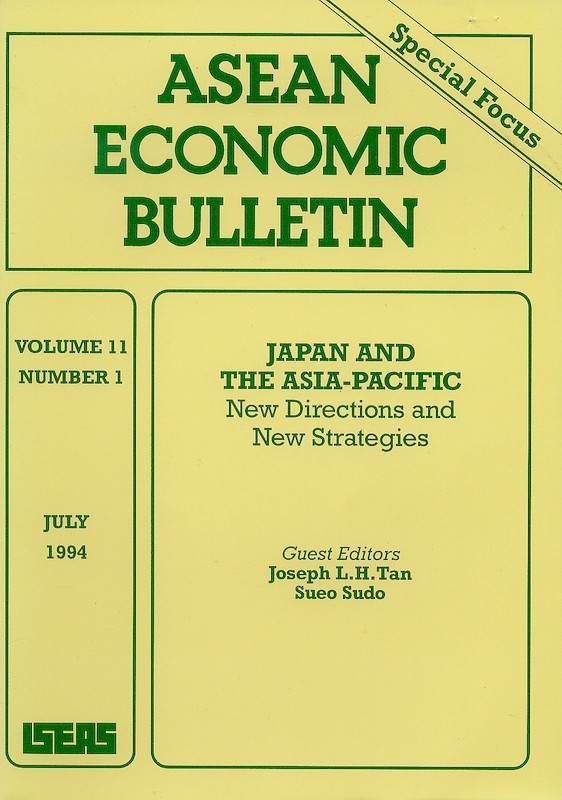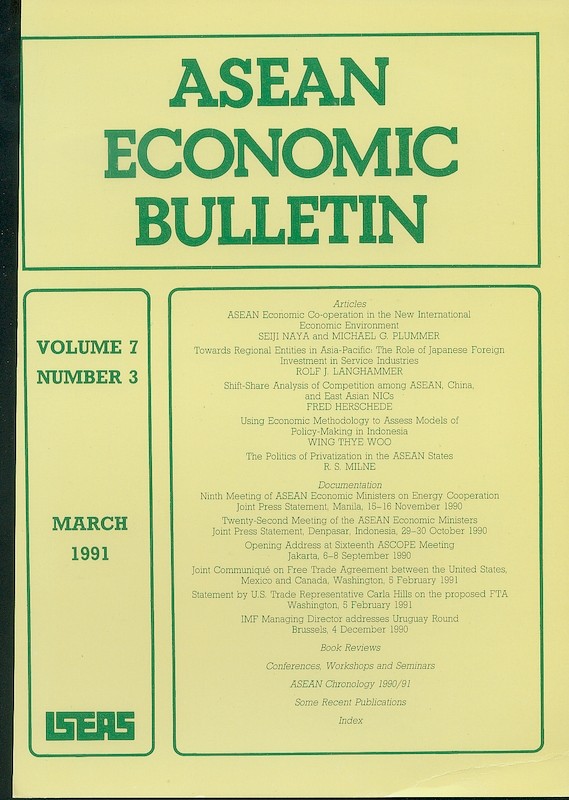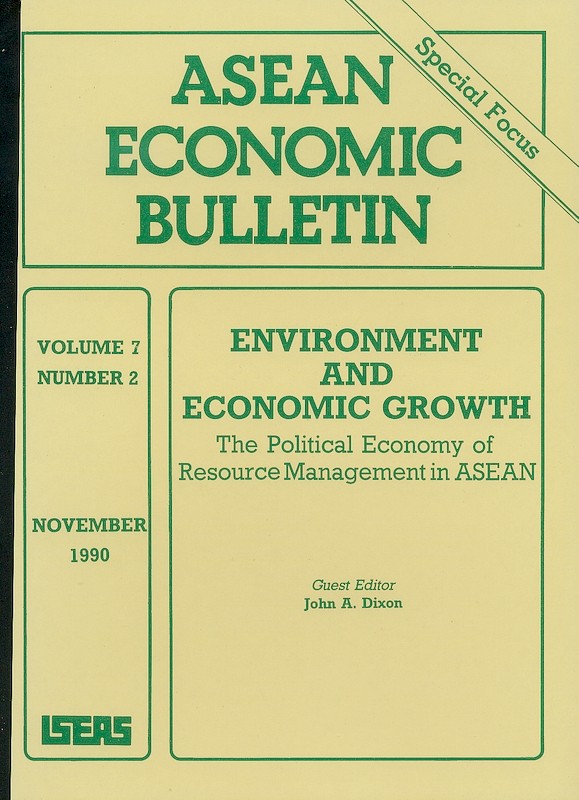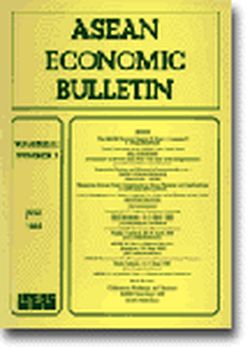ASEAN Economic Bulletin Vol. 11/3 (Mar 1995)

Date of publication:
March 1995
Publisher:
Institute of Southeast Asian Studies
Number of pages:
123
Code:
AE11/3
Contents
-
Preliminary pages
- ARTICLES
-
China's Economic Reform and Open-Door Policy Viewed from Southeast Asia, by John Wong, author see abstractIn the wake of successful economic reform, the Chinese economy has experienced spectacular growth. This in turn resulted in greater economic integration, with growing trade and investment flows between China and its neighbouring Asia-Pacific economies, including the Association of Southeast Asian Nations (ASEAN). Overall, such an integration process will enhance the development potential of both sides, but separately, ASEAN countries will continue to perceive their bilateral economic relations with China in the context of their individual historical and economic realities. While Malaysia, the Philippines, Singapore and Thailand generally view the opening up of China as a "benevolent stimulus" to their own economic growth, Indonesia still holds some reservation and tends to focus on the competitive aspects of the resurgent Chinese economy. Before their relationship matures, China needs to show greater sensitivity towards its smaller southern neighbours.
-
Intraregional Foreign Investment in East Asia, by Hans C Blomqvist, author see abstractThe purpose of this article is to give a picture of the development of intraregional foreign direct investment (FDI) in East Asia. The region today (excluding Japan) receives more than half of all FDI in less developed countries. Japan is still the biggest actor for intraregional investment, but the East Asian newly industrialized countries (NICs) have emerged as important investors in the 1980s and 1990s and are, relative to their size, more active foreign investors than Japan. ASEAN and China are also active as outward investors, but on a rather smaller scale compared to the former countries. The distribution of FDI industry-wise is also reported in this article. One interesting development is the high and rising share of services in FDI. A complicated network of transnational business is now rapidly developing in Asia-Pacific. Even in the absence of formal market integration, a degree of de facto integration has been developing for some time. In fact, the initiatives recently taken to bring about integration in the region seem to be propelled by the actual events instead of being the reason for them. The ASEAN Free Trade Area, now taking form, should provide new incentives for FDI, however.
-
The Determinants of Bilateral Trade Among Asia-Pacific Countries, by Joseph Yu Chwo-Ming, Dixie S Zietlow, authors see abstractUsing a gravity model, this article empirically tests the determinants of bilateral trade flows among fourteen Asia-Pacific countries. The results show that market size, political stability, physical distance, cultural similarity, membership in the Association of Southeast Asian Nations (ASEAN), and being a newly industrialized country are significant indicators of the bilateral trade relationships in the Pacific Basin.
-
Thailand's Internationalization and Its Rural Sector, by Medhi Krongkaew, author see abstractThe recent boom in the Thai economy is attributable mainly to three factors in the its external sectors, namely its export growth, its increase in revenue from tourism, and its increase in direct foreign investment. These developments have changed the Thai economic structure, and affected rural poverty and income inequality. Although the country has become more urbanized, most of the people still live in rural areas and have not fully benefited from the overall economic development. Employment migration to Bangkok, other cities and foreign countries has helped to augment rural income but at great personal costs. The government attempt to industrialize the rural areas in the past had not been successful due to the lack of rural infrastructure, economic agglomeration, and rural fiscal autonomy. However, the recent rise in the input cost of industrial production in Bangkok and the success of the new rural investment promotion initiatives could speed up rural industrialization and improve the life of the rural people.
-
Forest Conservation and Its Effects on Peninsular Malaysian Log Supply, by Mohamad Shahwahid Haji Othman, author see abstractExcessive logging and wastage in timber resources characterized Peninsular Malaysian forestry in the past. This inefficient system of forest taxation, procedures for allotting logging concessions and non-deterrent penalties were the main factors leading to these results. With the government-revived interest on forest conservation to ensure sustainable development, the annual logging hectares are expected to be curtailed. There is a need to identify supply responses to encourage further extraction of currently underutilized species from the forest. This model can be used to explain the potential effects of government management and conservation programmes on future domestic and imported supplies of logs to the peninsula.
-
Malaysia's International Offshore Financial Centre: An Examination of Labuan's Development and Operations, by Michael T Skully , author see abstractIn 1990, Malaysia announced its plan for a regional financial centre to be established on the island of Labuan. The government invested substantial funds in providing the appropriate legislation, infrastructure, and other factors required for a financial centre. This article examines Labuan's history thus far, and its current operations in offshore banking, offshore insurance, trust and funds management, and tax planning. The article concludes that while Labuan has made considerable progress in improving its competitive position against other centres, significantly more investment is still required.
-
DOCUMENTATION: APEC Economic Leaders' Declaration of Common Resolve in Bogor, Indonesia, 15 November 1994
-
DOCUMENTATION: Joint Statement at APEC Ministerial Meeting in Jakarta, 11-12 November 1994
-
DOCUMENTATION: APEC Non-Binding Investment Principles in Jakarta, 11-12 November 1994
-
DOCUMENTATION: World Economic Forum: Europe-East Asia Relations at a Crucial Point, in Singapore, 14 October 1994
-
BOOK REVIEW: The Uruguay Round: An Assessment, by Jeffrey J Schott, by Dean A DeRosa, author
-
BOOK REVIEW: 50 Years of Development Studies, by H W Arndt, by Robert L Curry, Jr., author
-
BOOK REVIEW: Business and Government in Industrializing Asia, edited by Andrew MacIntyre, by Francisco L Roman, Jr , author
-
Conferences, Workshops, and Seminars
-
ASEAN Chronology 1994
-
Recent Publications
-
Index to Volume 11




